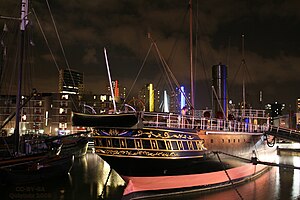HNLMS Buffel
 HNLMS Buffel in 2008
| |
| History | |
|---|---|
| Name | Buffel |
| Namesake | Water buffalo |
| Builder | Robert Napier and Sons, Glasgow, Scotland |
| Laid down | 10 June 1867 |
| Launched | 10 March 1868 |
| Completed | 22 July 1868 |
| Reclassified | As an accommodation ship , 11 June 1896 |
| Stricken | 1896 |
| Captured | May 1940 |
| Acquired | May 1940 |
| Captured | 8 May 1945 |
| Name | Buffel |
| Acquired | 8 May 1945 |
| Decommissioned | 1973 |
| Stricken | 1974 |
| Homeport | Den Helder |
| Identification |
|
| Status | Museum ship, 1974 |
| General characteristics (as completed) | |
| Class and type | Buffel-class monitor |
| Displacement | 2,402 long tons (2,441 t) |
| Length | 195 ft 10 in (59.7 m) (p/p) |
| Beam | 40 ft (12.2 m) |
| Draught | 16 ft 9 in (5.1 m) |
| Installed power |
|
| Propulsion | 2 shafts, 2 steam engines |
| Speed | 11 knots (20 km/h; 13 mph) |
| Complement | 159 |
| Armament |
|
| Armour |
|
HNLMS Buffel is a 19th-century
Construction and design
Built in 1868 by Robert Napier and Sons in Glasgow, Scotland, HNLMS Buffel was the first ship of the Royal Netherlands Navy without sails but with a steam engine and two propellers, that gave her a maximum speed of almost 13 knots (24 km/h). Her radius of action at 6 knots (11 km/h) was about 2,150 nautical miles (3,980 km). Her main task as an armor-clad ram ship was to play a role in the Dutch coastal defense together with two sister ships and two monitors.
Her armament was first of all the ram on her bow, mainly against wooden ships, and originally two 300-pound (140 kg), 23 cm (9 in)
The crew consisted of 150 officers, petty officers, and sailors.
Service record
The ship's only ocean voyage took place on her maiden trip in 1868 from Glasgow to Den Helder. During the voyage, the vessel rolled very much and took on a lot of water. From that day on Buffel remained in the North Sea (in accordance with her role) and her only foreign port of call was Antwerp, Belgium in 1871.
Buffel participated in many national exercises with the
In 1973 Buffel was
In October 2016 Stichting Museumschip de Buffel decided not to renew the three year lease. The group of volunteers then took up the idea to try to save the historical value of the ship for the future. In co-operation with the municipal councils of Rotterdam and Hellevoetsluis, this will be tried out in the coming year 2017.
See also
Bibliography
- Chesneau, Roger & Kolesnik, Eugene M., eds. (1979). Conway's All the World's Fighting Ships 1860–1905. Greenwich, UK: Conway Maritime Press. ISBN 0-8317-0302-4.
- "Dutch Ironclad Rams". Warship International. IX (3). Toledo, OH: Naval Records Club: 302–04. 1972.
- Silverstone, Paul H. (1984). Directory of the World's Capital Ships. New York: Hippocrene Books. ISBN 0-88254-979-0.
